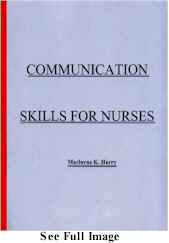|
Communication Skills for Nurses |

Describe two differences between effective versus ineffective communication.
Define the meaning of active listening.
Identify three skills necessary for active listening.
Describe three ways patients and coworkers benefit when nurses communicate effectively.
Discuss the difference between "I" statements and "You" statements.
Use three of each of these statements daily at work.
Contrast two ways that building trust differs in the clinical setting from other relationships.
Give three reasons that patients or coworkers are some- times unable to identify their feelings.
Give three examples of ways to assist patients and coworkers to express their feelings appropriately.
Identify two common communication problems that hinder the provision of high quality patient care.
Describe two ways that body language enhances communication.
State two specific body language messages that detract from effective communication.
Name three behaviors that signal supportive body language.
Explain the steps in a basic formula for effective communication.
Name three reasons that conflict erupts in the workplace.
Explain why conflict is a cycle.
Define the meaning of a trigger event or circumstance.
Name two examples of events or behaviors from which conflicts evolve at work.
Name two myths about conflict.
Give two ways that our feelings aid us in disrupting the cycle of conflict.
Describe the steps or behaviors that lead to the cycle of conflict.
Define the "Go Slowly" rule.
Name three common trust violations between nurses, patients, and coworkers.
Explain why it is important for nurses to talk to one another at work.
Practice at least ten ground rules for reestablishing on the job trust.
Define two rights and responsibilities of both nurses and patients in relation to equalizing power.
Define power play or power struggle.
Identify three common symbols people employ to increase their power and control in the workplace.
Define personal power.
Identify two relationships at work in which the power arrange- ment is unequal.
Describe one way that power inequalities lead to conflict.
Identify five tools used to assess whether a dispute involves a struggle to equalize power at work.
Describe two ways that your angry feelings assist you.
Practice three methods for increasing your awareness about nega- tive feelings and interactions at work.
Explain how your thoughts influence your response to conflict at work.
Name six thought changing strategies that influence outcomes of conflictive patterns at work.
Identify two underlying sources of conflict in the workplace.
Name six self-questioning tactics used to evaluate your role in con- flictive encounters at work.
Define your role or roles in your workplace.
Describe at least two negative aspects of work roles and how they relate to conflict.
Describe two ways that conflict decreases productivity at work.
Name three feelings that anger masks and the reason we hide these feelings during conflictive situations.
Give three skills for managing angry interactions with patients and coworkers.
Describe the steps in a model for effective confrontation of people and problems at work.
Define the term "boundary."
Name six ways that strengthening our boundaries enhances our work life.
Relate the importance of the self-reflective process to respecting patients’ and coworkers’ boundaries.
Identify two areas of strength in your boundaries at work.
Identify two areas of weakness in your own boundaries at work.
Describe "semi-permeable or selective process" at it relates to boundaries.
Name at least two consequences of inadequate boundaries at work.
Give five examples of ways that nurses unwittingly devalue or depersonalize their patients.
Identify three visible boundaries at work.
Identify three invisible boundaries that all people have.
Describe three common behaviors that trespass on pa tients’ or coworkers’ visible boundaries.
Define the term "belief."
Identify five of your beliefs.
Define the term "value."
Identify five of your values.
Identify two consequences of working in contradiction of your values.
Name five characteristics of rigid boundaries.
Name five characteristics of weak boundaries.
Give two reasons why firm yet flexible boundaries increase productivity and augment the level of patient care.
Define emotional boundary.
Define mental boundary.
Define spiritual boundary.
Identify two guidelines for maintaining emotional boundaries at work.
Give two guidelines for maintaining mental boundaries at work.
Describe two guidelines for maintaining spiritual boundaries at work.
Evaluation of Individual Objectives
To assess the effectiveness of the course material, we ask that you evaluate your achievement of each learning objective on a scale of A to D (A=excellent, B=good, C=fair, D=unsatisfactory). Please indicate your responses next to each learning objective and return it to us with your completed exam.
Comments
"I found the course very useful
in my daily working environment, especially dealing with co- workers."
- D.S., Petaluma, CA
" Worth reading, very helpful, I wish every nurse read the book and would try to
put it into practice." -
P.B., Saint Petersburg, FL.
"Very insightful!" -
S.N., Van Nuys, CA
"I will let others in the hospital use the book, which will help them."
-
M.B., Hawthorne, NV
PART ONE : Effective versus Ineffective Communication
PART TWO : Managing Conflict in the Workplace
PART THREE : Boundaries in the Workplace
|
© 2007 Homestead Schools, Inc. - Webmaster : Shawn J. Cassick |